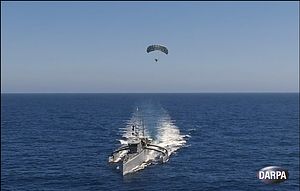The Defense Advanced Research Projects Agency (DARPA), a Pentagon agency responsible for developing and testing new military technologies, has been successfully testing a new low-cost sensor system for its Anti-Submarine Warfare (ASW) Continuous Trail Unmanned Vessel (ACTUV), according to a DARPA press release.
Developed under the so-called Towed Airborne Lift of Naval Systems (TALONS) research program, the new prototype is a winch-attached parachute capable of carrying intelligence, surveillance, reconnaissance (ISR), and communications payloads of up to 150 pounds between 500 and 1,500 feet in altitude.
Several tests of the TALONS prototype were conducted while the ACTUV — a 132-feet (40 meters) long and 140-ton heavy unmanned autonomous trimaran prototype — was undergoing open-water testing off the coast of California in October. The tests took place over two days with 90 minutes of light each day.
“While aloft, TALONS demonstrated significant improvements to the range of the sensors and radios it carried compared to mounting them directly on a surface vessel. For example, TALONS’ surface-track radar extended its range by 500 percent — six times — compared to its range at sea level. Its electro-optical/infrared scanner doubled its observed discrimination range,” DARPA states.
“TALONS showed the advantages of using a low-cost add-on elevated sensor to extend the vision and connectivity of a surface asset and ACTUV demonstrated its ability as a flexible and robust payload truck,” said Dan Patt, DARPA program manager for TALONS. “This demonstration was an important milestone in showing how clever use of unmanned systems could cost-effectively provide improved capabilities.”
DARPA is also developing other non-conventional sensor technologies to facilitate the correct identification of surface ships and other objects while at sea. “Autonomous compliance with maritime laws requires the correct identification of surface ships and other objects while at sea,” I explained last year.
The ACTUV has also been fitted with the new Raytheon Modular Scalable Sonar System (MS3), the vessel’s primary search-and-detection sonar, capable of conducting active and passive sonar searches.
As I noted earlier in the year, the ACTUV is specifically designed to track quiet diesel-electric submarines (See: “World’s Largest Anti-Submarine Robot Ship Ready for Sea-Trials in April”):
The ship’s primary mission will be tracking enemy subs in shallow waters. Furthermore, (…) the ACTUV is designed to operate autonomously for 60 to 90 days straight, surveil large stretches of ocean territory and — should an enemy sub be spotted — guide other U.S. naval assets to the vessel’s location to destroy it (the ACTUV itself is unarmed).
It will cost approximately $15,000 to $20,000 per day to operate. (In comparison, an Aegis guided-missile destroyer costs around $700,000 to operate per day.)

































